-
了解list

1. list的介绍及使用
1.1 list的介绍
C++中的list是一个双向链表,它是一个STL容器,可以用来存储任何类型的数据。list容器中的元素可以在任何位置插入或删除,而不会影响其他元素。list容器中的元素按照它们在容器中出现的顺序进行排序。可以使用STL算法对list容器进行排序、查找和操作。可以使用迭代器访问list容器中的元素。
1.2 list的使用
list中的接口比较多,此处类似,只需要掌握如何正确的使用,然后再去深入研究背后的原理,已达到可扩展的能力。以下为list中一些常见的重要接口。
1.2.1 list的构造
default (1) explicit list ()); //构造空的list
fill (2) explicit list (size_type n, const value_type& val = value_type(), const allocator_type& alloc = allocator_type()); //构造的list中包含n个值为val的元素
range (3) template < class InputIterator >
list (InputIterator first, InputIterator last, const allocator_type & alloc = allocator_type()); //用[first, last)区间中的元素构造list
copy (4) list (const list& x); //拷贝构造函数1.2.2 list iterator的使用

【注意】- begin与end为正向迭代器,对迭代器执行++操作,迭代器向后移动
- rbegin(end)与rend(begin)为反向迭代器,对迭代器执行++操作,迭代器向前移动
list迭代器是一个双向迭代器,list的迭代器支持前置和后置自增运算符,以及前置和后置自减运算符。list的迭代器还支持解引用运算符,可以返回指向当前元素的引用。此外,list的迭代器还支持比较运算符,可以比较两个迭代器是否相等。
#includeusing namespace std; #include - 1
- 2
- 3
- 4
- 5
- 6
- 7
- 8
- 9
- 10
- 11
- 12
- 13
- 14
- 15
- 16
- 17
- 18
- 19
- 20
- 21
- 22
- 23
- 24
- 25
- 26
- 27
- 28
- 29

#includeusing namespace std; #include - 1
- 2
- 3
- 4
- 5
- 6
- 7
- 8
- 9
- 10
- 11
- 12
- 13
- 14
- 15
- 16
- 17
- 18
- 19
- 20
- 21
- 22
- 23
- 24
- 25

1.2.3 list capacity

list没有容量概念,但是有可以容纳的最大元素数。#includeusing namespace std; #include - 1
- 2
- 3
- 4
- 5
- 6
- 7
- 8
- 9
- 10
- 11
- 12
- 13
- 14
- 15
- 16

1.2.4 list element access

front :返回list的第一个节点中值的引用
back :返回list的最后一个节点中值的引用int main() { list<int> mylist = { 77,12,23,22 }; // now front equals 77, and back 22 mylist.front() -= mylist.back(); cout << "mylist.front() is now " << mylist.front() << '\n'; return 0; }- 1
- 2
- 3
- 4
- 5
- 6
- 7
- 8
- 9

1.2.5 list modifiers
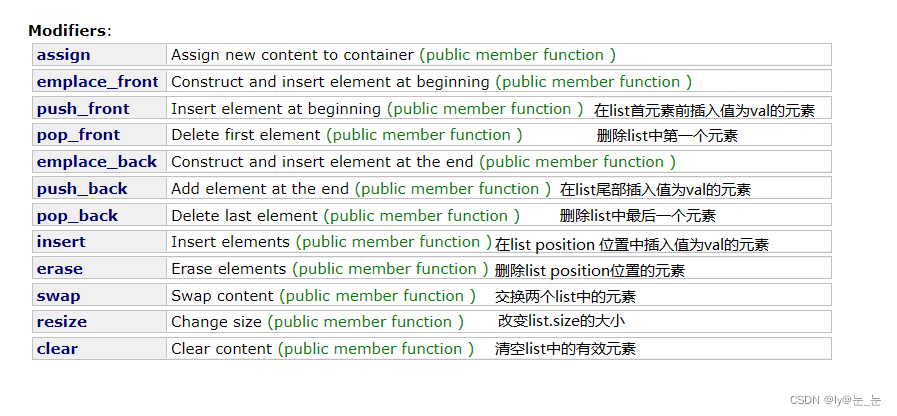
1. resize
int main() { list<int> mylist; // set some initial content: for (int i = 1; i < 10; ++i) mylist.push_back(i); mylist.resize(5); mylist.resize(8, 100); mylist.resize(12); cout << "mylist contains:"; for (list<int>::iterator it = mylist.begin(); it != mylist.end(); ++it) cout << ' ' << *it; cout << endl; return 0; }- 1
- 2
- 3
- 4
- 5
- 6
- 7
- 8
- 9
- 10
- 11
- 12
- 13
- 14
- 15
- 16
- 17

2. push_back/pop_back/push_front/pop_front
int main() { int array[] = { 1, 2, 3 }; list<int> L(array, array + sizeof(array) / sizeof(array[0])); // 在list的尾部插入4,头部插入0 L.push_back(4); L.push_front(0); list<int>::iterator it = L.begin(); while (it != L.end()) { cout << *it << ' '; ++it; } cout << endl; // 删除list尾部节点和头部节点 L.pop_back(); L.pop_front(); it = L.begin(); while (it != L.end()) { cout << *it << ' '; ++it; } cout << endl; }- 1
- 2
- 3
- 4
- 5
- 6
- 7
- 8
- 9
- 10
- 11
- 12
- 13
- 14
- 15
- 16
- 17
- 18
- 19
- 20
- 21
- 22
- 23
- 24
- 25
- 26
- 27

3. insert /erase
int main() { int array1[] = { 1, 2, 3 }; list<int> L(array1, array1 + sizeof(array1) / sizeof(array1[0])); // 获取链表中第二个节点 auto pos = ++L.begin(); cout << *pos << endl; // 在pos前插入值为4的元素 L.insert(pos, 4); list<int>::iterator it = L.begin(); while (it != L.end()) { cout << *it << ' '; ++it; } cout << endl; // 在pos前插入5个值为5的元素 L.insert(pos, 5, 5); it = L.begin(); while (it != L.end()) { cout << *it << ' '; ++it; } cout << endl; // 删除pos位置上的元素 L.erase(pos); it = L.begin(); while (it != L.end()) { cout << *it << ' '; ++it; } cout << endl; // 删除list中[begin, end)区间中的元素,即删除list中的所有元素 L.erase(L.begin(), L.end()); it = L.begin(); while (it != L.end()) { cout << *it << ' '; ++it; } cout << endl; return 0; }- 1
- 2
- 3
- 4
- 5
- 6
- 7
- 8
- 9
- 10
- 11
- 12
- 13
- 14
- 15
- 16
- 17
- 18
- 19
- 20
- 21
- 22
- 23
- 24
- 25
- 26
- 27
- 28
- 29
- 30
- 31
- 32
- 33
- 34
- 35
- 36
- 37
- 38
- 39
- 40
- 41
- 42
- 43
- 44
- 45
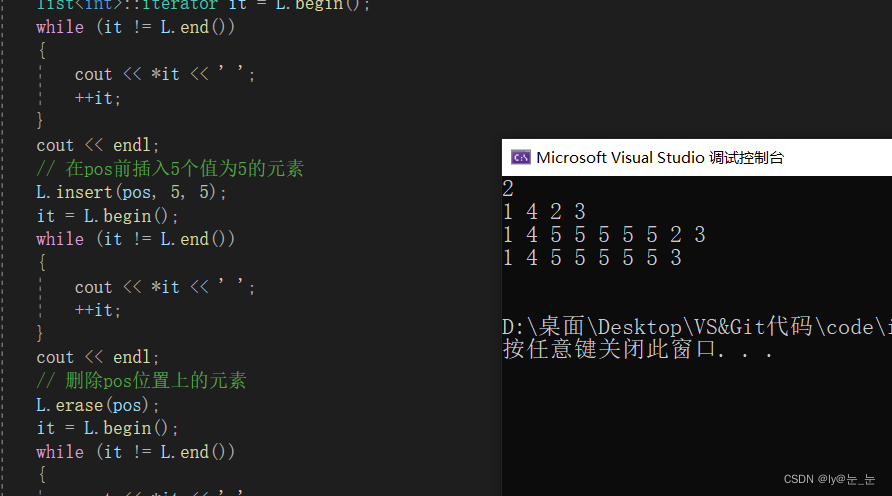
4. swap/clear
int main() { // 用数组来构造list int array1[] = { 1, 2, 3 }; list<int> l1(array1, array1 + sizeof(array1) / sizeof(array1[0])); list<int>::iterator it = l1.begin(); cout << "l1:"; while (it != l1.end()) { cout << *it << ' '; ++it; } cout << endl; // 交换l1和l2中的元素 list<int> l2; l1.swap(l2); it = l1.begin(); cout << "l1:"; while (it != l1.end()) { cout << *it << ' '; ++it; } cout << endl; cout << "l2:"; it = l2.begin(); while (it != l2.end()) { cout << *it << ' '; ++it; } cout << endl; // 将l2中的元素清空 l2.clear(); cout << "l2.size:" << l2.size() << endl; }- 1
- 2
- 3
- 4
- 5
- 6
- 7
- 8
- 9
- 10
- 11
- 12
- 13
- 14
- 15
- 16
- 17
- 18
- 19
- 20
- 21
- 22
- 23
- 24
- 25
- 26
- 27
- 28
- 29
- 30
- 31
- 32
- 33
- 34
- 35
- 36
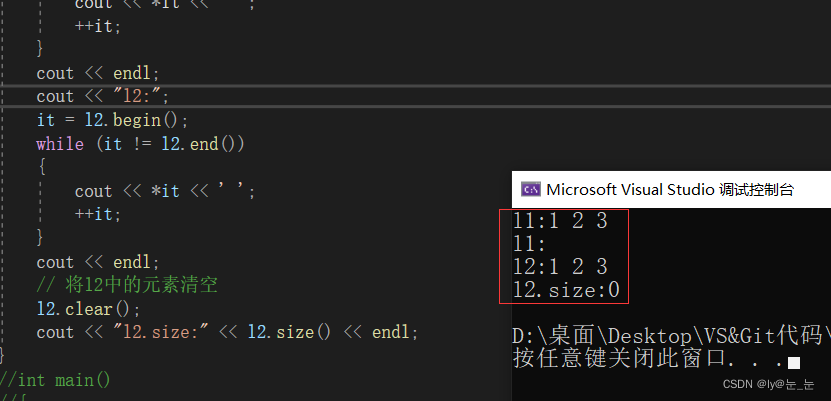
1.2.6 list operations
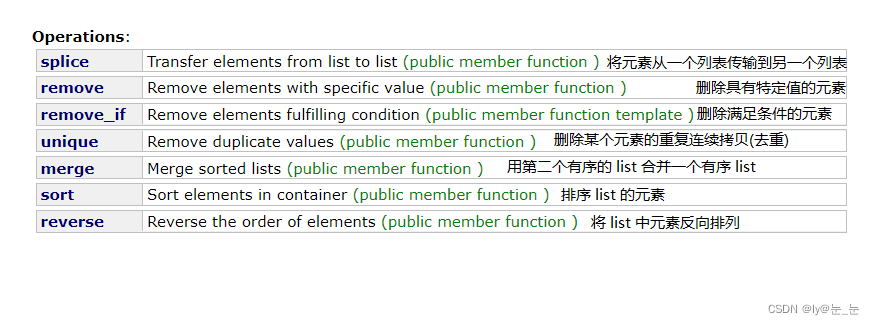
1. splice
splice()函数用于将元素从一个列表传输到另一个列表。它有三个重载版本:
- list1.splice(position, list2):将list2中的所有元素剪贴到list1的position位置;
- list1.splice(position, list2, iter):将list2中某个位置的迭代器iter指向的元素剪贴到list1中的position位置;
- list1.splice(position, list2, first, last):将list2中[first,last)区间内的元素剪贴到list1中的position位置。
int main() { //list1.splice(position, list2, first, last):将list2中[first, last)区间内的元素剪贴到list1中的position位置 list<int> l1 = { 1,2,3,4,5 }; list<int> l2 = { 6,7,8,9,10 }; list<int>::iterator position = l1.begin(); ++position; //2 list<int>::iterator first = l2.begin(); ++first; //7 list<int>::iterator last = l2.end(); --last; //10 l1.splice(position, l2, first, last); list<int>::iterator it = l1.begin(); while (it != l1.end()) { cout << *it << ' '; ++it; } cout << endl; return 0; }- 1
- 2
- 3
- 4
- 5
- 6
- 7
- 8
- 9
- 10
- 11
- 12
- 13
- 14
- 15
- 16
- 17
- 18

2.remove_if
remove_if()用于从范围[first,last)中删除满足特定条件的所有元素,并返回新范围的超尾迭代器。已删除的元素不会从容器中物理删除,它们的内存仍然分配。该函数仅在删除后返回容器的新结尾迭代器。
int main() { list<int> v{ 1, 2, 3, 4, 5 }; v.erase(remove_if(v.begin(), v.end(), [](int i) {return i % 2 == 0; }), v.end()); for (auto i : v) { cout << i << " "; } cout << endl; return 0; }- 1
- 2
- 3
- 4
- 5
- 6
- 7
- 8
- 9
- 10
- 11
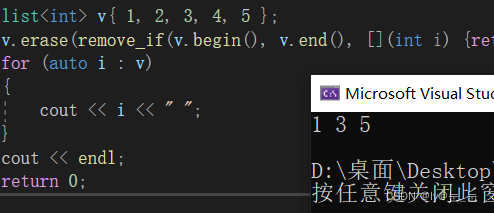
在此示例中,我们有一个包含1到5的整数list。我们使用remove_if()从向量中删除所有偶数。lambda函数[](int i){return i % 2 == 0;}检查整数是否为偶数。该函数返回一个迭代器,指向删除后向量的新结尾。然后我们使用erase()将所有元素从返回的迭代器到向量末尾删除。
3.sort/reverse
int main() { list<int> l = { 3,5,2,1,4 }; l.sort(); //默认升序 list<int>::iterator it = l.begin(); while (it != l.end()) { cout << *it << ' '; ++it; } cout << endl; l.sort(greater<int>());//降序 it = l.begin(); while (it != l.end()) { cout << *it << ' '; ++it; } cout << endl; l.reverse();//翻转链表 it = l.begin(); while (it != l.end()) { cout << *it << ' '; ++it; } cout << endl; }- 1
- 2
- 3
- 4
- 5
- 6
- 7
- 8
- 9
- 10
- 11
- 12
- 13
- 14
- 15
- 16
- 17
- 18
- 19
- 20
- 21
- 22
- 23
- 24
- 25
- 26
- 27
- 28

1.2.7 list的迭代器失效
在C++中,当使用std::list容器的迭代器时,可能会遇到迭代器失效的问题。迭代器失效是指,当修改容器时,指向容器元素的迭代器可能会失效。以下是一些导致迭代器失效的常见情况:
当使用erase()方法删除元素时,指向被删除元素的迭代器将失效。
当使用insert()方法插入元素时,指向插入位置之后的所有元素的迭代器将失效。
当容器扩容时,所有指向容器元素的迭代器都将失效。void TestIterator1() { list<int> l = { 1,2,3,4,5,6 }; list<int>::iterator it = l.begin(); while (it != l.end()) { l.erase(it); ++it; } } void TestIterator2() { list<int> l = { 1,2,3,4,5,6 }; list<int>::iterator it = l.begin(); while (it != l.end()) { it = l.erase(it); ++it; } }- 1
- 2
- 3
- 4
- 5
- 6
- 7
- 8
- 9
- 10
- 11
- 12
- 13
- 14
- 15
- 16
- 17
- 18
- 19
- 20
TestIterator1():
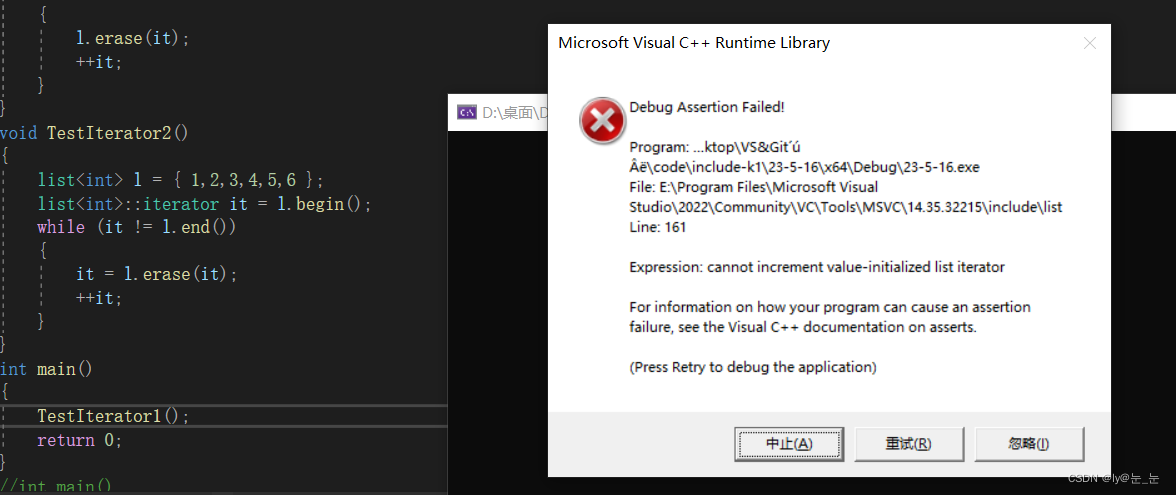
TestIterator2():
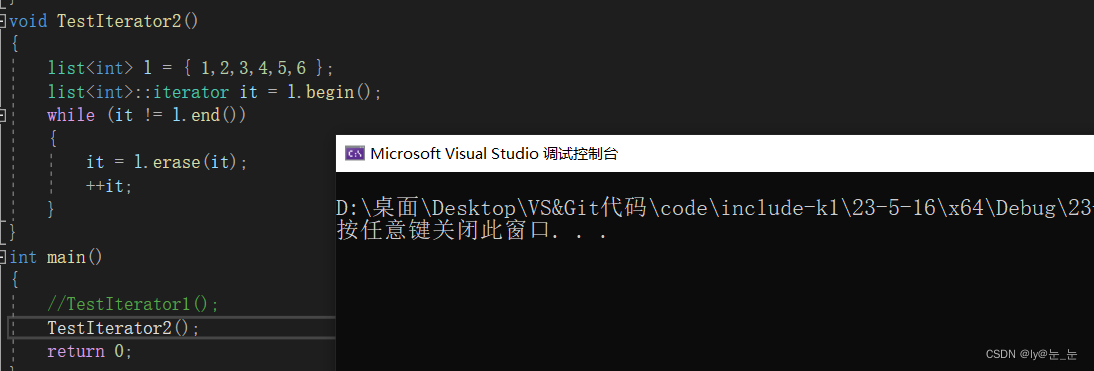
2. list的深度剖析及模拟实现
模拟实现list时要先构造一个命名空间,防止调用的时候调用库函数中的内容。
2.1 list_node
模拟实现list,首先需要定义list_node,c++中任何一种结构,都是从空开始,然后用数学方式慢慢搭建而成,所以数学还是很重要的。
template<class T> struct list_node { list_node<T>* _next; list_node<T>* _prev; T _data; list_node(const T& x = T()) :_next(nullptr) ,_prev(nullptr) ,_data(x) {} };- 1
- 2
- 3
- 4
- 5
- 6
- 7
- 8
- 9
- 10
- 11
- 12
- 13
2.2 __list_iterator
接下来实现迭代器,list会调用是个迭代器
//迭代器的封装 // 1、迭代器要么就是原生指针 // 2、迭代器要么就是自定义类型对原生指针的封装,模拟指针的行为 template<class T> struct __list_iterator { typedef list_node<T> node; typedef __list_iterator<T> self; //self这个就是迭代器 node* _node; __list_iterator(node* n) :_node(n) {} T& operator*() { return _node->_data; } //下面就是完成对self(迭代器)的一些操作,如:it++,it--等 self& operator++() { _node = _node->_next; return *this; } self operator++(int) //前置++ { self tmp(*this); _node = _node->_next; return tmp; } self& operator--() { _node = _node->_prev; return *this; } self operator--(int) //前置-- { self tmp(*this); _node = _node->_prev; return tmp; } bool operator!=(const self& s) { return _node != s._node; } bool operator==(const self& s) { return _node == s._node; } };- 1
- 2
- 3
- 4
- 5
- 6
- 7
- 8
- 9
- 10
- 11
- 12
- 13
- 14
- 15
- 16
- 17
- 18
- 19
- 20
- 21
- 22
- 23
- 24
- 25
- 26
- 27
- 28
- 29
- 30
- 31
- 32
- 33
- 34
- 35
- 36
- 37
- 38
- 39
- 40
- 41
- 42
- 43
- 44
- 45
- 46
- 47
- 48
- 49
- 50
- 51
这个迭代器的实现较简单,但是这只是迭代器中的一部分,后面还有补充
2.3 list
template<class T> class list { typedef list_node<T> node; public: typedef __list_iterator<T> iterator; iterator begin() { return iterator(_head->_next); } iterator begin() const { return iterator(_head->_next); } iterator end() { return iterator(_head); } iterator end() const { return iterator(_head); } void empty_init() { _head = new node; _head->_next = _head; _head->_prev = _head; } list() { empty_init(); } list(int n, const T& x = T()) { empty_init();//先初始化_head,否则_head为空 while (n) { node* new_node = new node(x); node* tail = _head->_prev; _head->_prev = new_node; tail->_next = new_node; new_node->_prev = tail; new_node->_next = _head; --n; } } void swap(list<T>& tmp) { //在nampspace k这个命名空间中,需要使用的是c库中的swap(就近原则) std::swap(_head, tmp._head); } list(const list<T>& lt) { empty_init(); list<T> tmp(lt.begin(), lt.end()); swap(tmp); } template<class iterator> list(iterator first, iterator last) { empty_init(); //先初始化_head,否则_head为空 while (first != last) { push_back(*first); ++first; } } // lt1 = lt2 list<T>& operator=(list<T> lt) { swap(lt); return *this; } ~list() { clear(); delete _head; _head = nullptr; } void clear() { iterator it = begin(); while (it != end()) { //it = erase(it); erase(it++); } } iterator insert(iterator pos, const T& x) { node* cur = pos._node; node* prev = cur->_prev; node* new_node = new node(x); prev->_next = new_node; new_node->_prev = prev; new_node->_next = cur; cur->_prev = new_node; return iterator(new_node); } iterator erase(iterator pos) { assert(pos != end()); node* prev = pos._node->_prev; node* next = pos._node->_next; prev->_next = next; next->_prev = prev; delete pos._node; return iterator(next); } void push_back(const T& x = T()) { insert(end(), x); } void push_front(const T& x = T()) { insert(begin(), x); } void pop_back() { erase(--end()); } void pop_front() { erase(begin()); } private: node* _head; };- 1
- 2
- 3
- 4
- 5
- 6
- 7
- 8
- 9
- 10
- 11
- 12
- 13
- 14
- 15
- 16
- 17
- 18
- 19
- 20
- 21
- 22
- 23
- 24
- 25
- 26
- 27
- 28
- 29
- 30
- 31
- 32
- 33
- 34
- 35
- 36
- 37
- 38
- 39
- 40
- 41
- 42
- 43
- 44
- 45
- 46
- 47
- 48
- 49
- 50
- 51
- 52
- 53
- 54
- 55
- 56
- 57
- 58
- 59
- 60
- 61
- 62
- 63
- 64
- 65
- 66
- 67
- 68
- 69
- 70
- 71
- 72
- 73
- 74
- 75
- 76
- 77
- 78
- 79
- 80
- 81
- 82
- 83
- 84
- 85
- 86
- 87
- 88
- 89
- 90
- 91
- 92
- 93
- 94
- 95
- 96
- 97
- 98
- 99
- 100
- 101
- 102
- 103
- 104
- 105
- 106
- 107
- 108
- 109
- 110
- 111
- 112
- 113
- 114
- 115
- 116
- 117
- 118
- 119
- 120
- 121
- 122
- 123
- 124
- 125
- 126
- 127
- 128
- 129
- 130
- 131
- 132
- 133
- 134
list的构造中,需要注意的就是先初始化_head,否则_head为空,对head的一些操作(如:_head->_prev = new_node)就会导致空指针的使用;list(const list& lt)这个构造的思路挺好,剩下的就是一些基本操作。
2.3 __list_const_iterator
__list_const_iterator与__list_iterator的区别就是是否可以修改链表中的内容,所以对T& operator*() 时,返回const T& operator* 即可。
template<class T> struct __list_const_iterator { typedef list_node<T> node; typedef __list_const_iterator<T> self; node* _node; __list_const_iterator(node* n) :_node(n) {} const T& operator*() { return _node->_data; } .......省略 };- 1
- 2
- 3
- 4
- 5
- 6
- 7
- 8
- 9
- 10
- 11
- 12
- 13
- 14
- 15
- 16
- 17
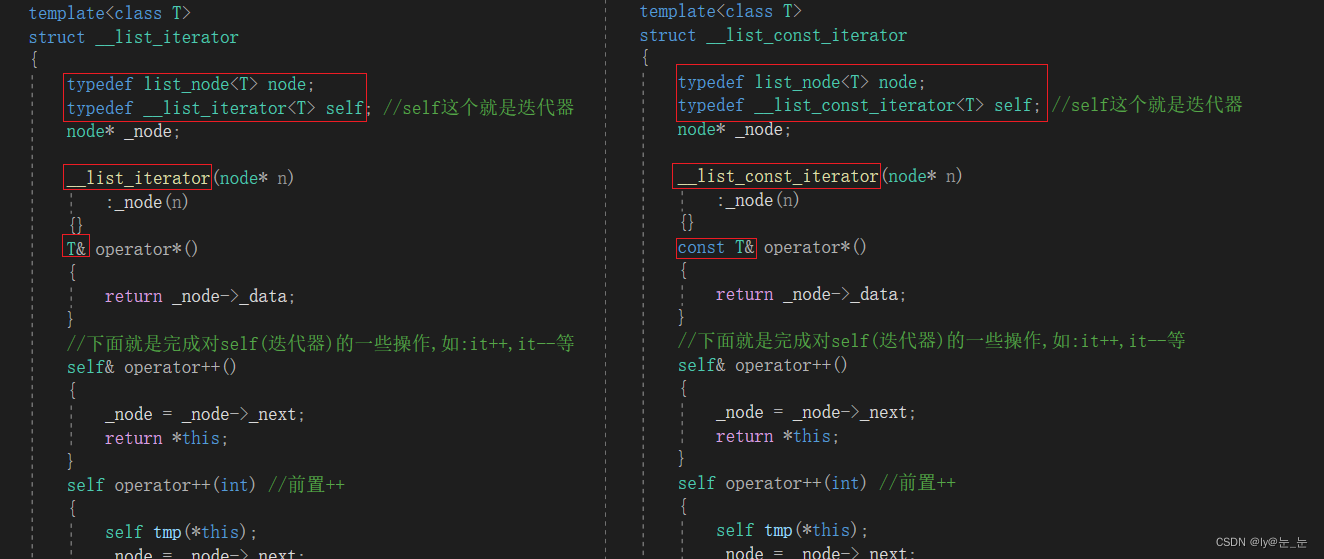
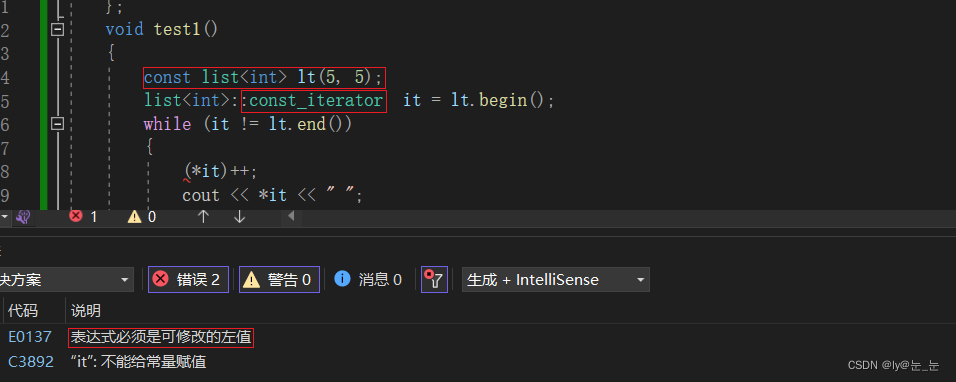
所以当调用iterator时,调用的是T&;当调用const_iterator时,调用的是const T&
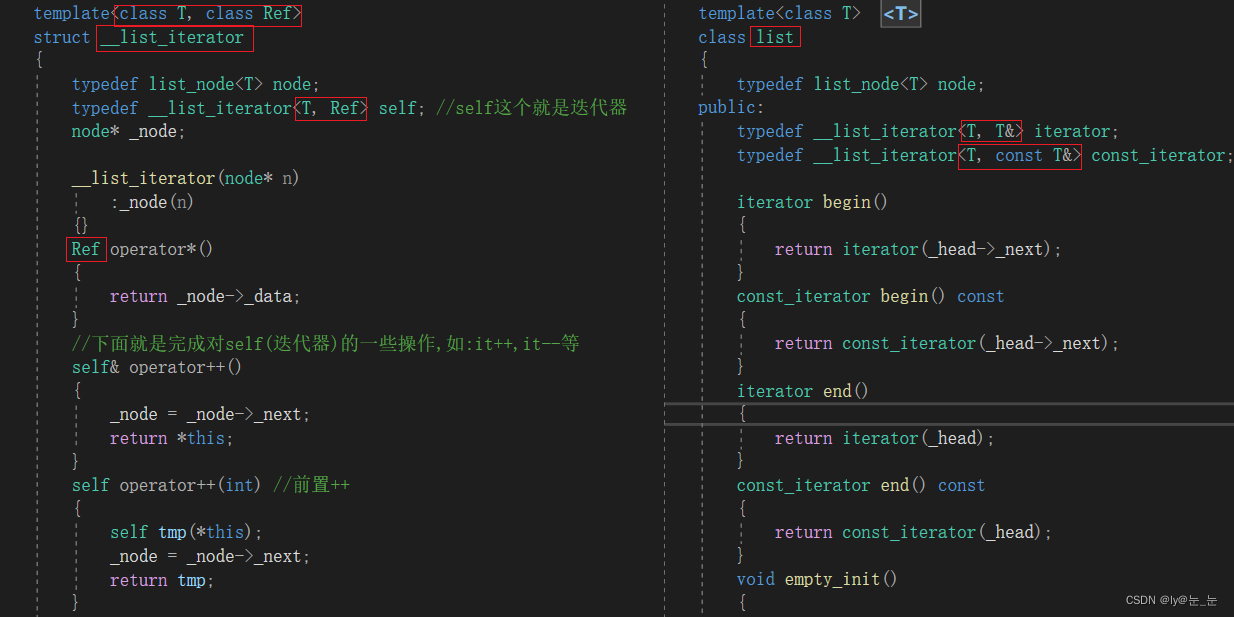
然后再加一个const T*,完整代码如下:namespace k { template<class T> struct list_node { list_node<T>* _next; list_node<T>* _prev; T _data; list_node(const T& x = T()) :_next(nullptr) ,_prev(nullptr) ,_data(x) {} }; //迭代器的封装 // 1、迭代器要么就是原生指针 // 2、迭代器要么就是自定义类型对原生指针的封装,模拟指针的行为 template<class T, class Ref, class Ptr> struct __list_iterator { typedef list_node<T> node; typedef __list_iterator<T, Ref, Ptr> self; //self这个就是迭代器 node* _node; __list_iterator(node* n) :_node(n) {} Ref operator*() { return _node->_data; } Ptr operator->() { return &_node->_data; } //下面就是完成对self(迭代器)的一些操作,如:it++,it--等 self& operator++() { _node = _node->_next; return *this; } self operator++(int) //前置++ { self tmp(*this); _node = _node->_next; return tmp; } self& operator--() { _node = _node->_prev; return *this; } self operator--(int) //前置-- { self tmp(*this); _node = _node->_prev; return tmp; } bool operator!=(const self& s) { return _node != s._node; } bool operator==(const self& s) { return _node == s._node; } }; template<class T> class list { typedef list_node<T> node; public: typedef __list_iterator<T, T&, T*> iterator; typedef __list_iterator<T, const T&, const T*> const_iterator; iterator begin() { return iterator(_head->_next); } const_iterator begin() const { return const_iterator(_head->_next); } iterator end() { return iterator(_head); } const_iterator end() const { return const_iterator(_head); } void empty_init() { _head = new node; _head->_next = _head; _head->_prev = _head; } list() { empty_init(); } list(int n, const T& x = T()) { empty_init();//先初始化_head,否则_head为空 while (n) { node* new_node = new node(x); node* tail = _head->_prev; _head->_prev = new_node; tail->_next = new_node; new_node->_prev = tail; new_node->_next = _head; --n; } } void swap(list<T>& tmp) { //在nampspace k这个命名空间中,需要使用的是c库中的swap(就近原则) std::swap(_head, tmp._head); } list(const list<T>& lt) { empty_init(); list<T> tmp(lt.begin(), lt.end()); swap(tmp); } template<class iterator> list(iterator first, iterator last) { empty_init(); //先初始化_head,否则_head为空 while (first != last) { push_back(*first); ++first; } } // lt1 = lt2 list<T>& operator=(list<T> lt) { swap(lt); return *this; } ~list() { clear(); delete _head; _head = nullptr; } void clear() { iterator it = begin(); while (it != end()) { //it = erase(it); erase(it++); } } iterator insert(iterator pos, const T& x) { node* cur = pos._node; node* prev = cur->_prev; node* new_node = new node(x); prev->_next = new_node; new_node->_prev = prev; new_node->_next = cur; cur->_prev = new_node; return iterator(new_node); } iterator erase(iterator pos) { assert(pos != end()); node* prev = pos._node->_prev; node* next = pos._node->_next; prev->_next = next; next->_prev = prev; delete pos._node; return iterator(next); } void push_back(const T& x = T()) { insert(end(), x); } void push_front(const T& x = T()) { insert(begin(), x); } void pop_back() { erase(--end()); } void pop_front() { erase(begin()); } private: node* _head; }; void test1() { list<int> lt(5, 5); list<int>::iterator it = lt.begin(); while (it != lt.end()) { //(*it)++; cout << *it << " "; ++it; } cout << endl; } }- 1
- 2
- 3
- 4
- 5
- 6
- 7
- 8
- 9
- 10
- 11
- 12
- 13
- 14
- 15
- 16
- 17
- 18
- 19
- 20
- 21
- 22
- 23
- 24
- 25
- 26
- 27
- 28
- 29
- 30
- 31
- 32
- 33
- 34
- 35
- 36
- 37
- 38
- 39
- 40
- 41
- 42
- 43
- 44
- 45
- 46
- 47
- 48
- 49
- 50
- 51
- 52
- 53
- 54
- 55
- 56
- 57
- 58
- 59
- 60
- 61
- 62
- 63
- 64
- 65
- 66
- 67
- 68
- 69
- 70
- 71
- 72
- 73
- 74
- 75
- 76
- 77
- 78
- 79
- 80
- 81
- 82
- 83
- 84
- 85
- 86
- 87
- 88
- 89
- 90
- 91
- 92
- 93
- 94
- 95
- 96
- 97
- 98
- 99
- 100
- 101
- 102
- 103
- 104
- 105
- 106
- 107
- 108
- 109
- 110
- 111
- 112
- 113
- 114
- 115
- 116
- 117
- 118
- 119
- 120
- 121
- 122
- 123
- 124
- 125
- 126
- 127
- 128
- 129
- 130
- 131
- 132
- 133
- 134
- 135
- 136
- 137
- 138
- 139
- 140
- 141
- 142
- 143
- 144
- 145
- 146
- 147
- 148
- 149
- 150
- 151
- 152
- 153
- 154
- 155
- 156
- 157
- 158
- 159
- 160
- 161
- 162
- 163
- 164
- 165
- 166
- 167
- 168
- 169
- 170
- 171
- 172
- 173
- 174
- 175
- 176
- 177
- 178
- 179
- 180
- 181
- 182
- 183
- 184
- 185
- 186
- 187
- 188
- 189
- 190
- 191
- 192
- 193
- 194
- 195
- 196
- 197
- 198
- 199
- 200
- 201
- 202
- 203
- 204
- 205
- 206
- 207
- 208
- 209
- 210
- 211
- 212
- 213
- 214
- 215
- 216
- 217
- 218
- 219
-
相关阅读:
Deformable DETR(2020 ICLR)
黑猫带你学UFS协议第2篇:UFS相关名词释义
“一个优秀程序员可抵五个普通程序员!”
光猫桥接与直接拨号的对比
【听如子说】-python模块系列-AIS编解码Pyais
zookeeper整合ElasticJob实现任务调度
ES6知识总结
Java架构师常见基础面试题(附答案)
城商行两地三中心存储架构设计实践分享
建立一个数据机房的条件
- 原文地址:https://blog.csdn.net/weixin_68278653/article/details/130824403
